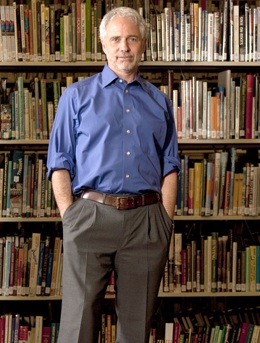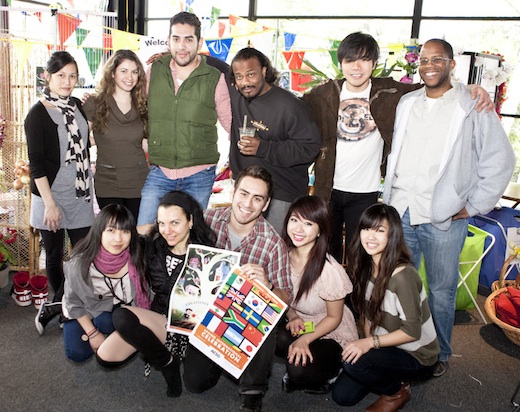Earlier this year, Art Center College of Design launched Create Change, our strategic plan for becoming the preeminent college of art and design in the 21st century.
With Fall graduation events set for tomorrow and the winter break nearly upon us, we felt it was the perfect time to sit down with Art Center College of Design President Lorne M. Buchman to hear his thoughts on the past year, get an update on the strategic plan and find out what’s in store for the coming year.
Dotted Line: Looking back at the past year, what are your first thoughts?
Lorne M. Buchman: I’d like to begin by expressing how deeply gratified I am by all that we’ve accomplished. This has been a banner year for Art Center. We’ve seen record enrollment of talented and gifted students, we launched our strategic plan and we are set to begin new degree programs in Fall 2012. We’re closing in on the purchase of the post office property adjacent to South Campus, a facility for which we’ve raised significant funds to purchase. We’ve built the Board and we’ve recruited some dynamic new faculty. We are connecting with alumni the world over. We’ve offered some fabulous new courses and we’ve made significant strides in acquiring new technology and equipment for our students. I could go on and on. It’s been remarkable. And all of this doesn’t happen by accident. The driving force of our success is the focused and diligent work of our trustees, faculty and staff. We should recognize with much gratitude the quality of this extraordinary community.
More questions with President Lorne M. Buchman after the jump.
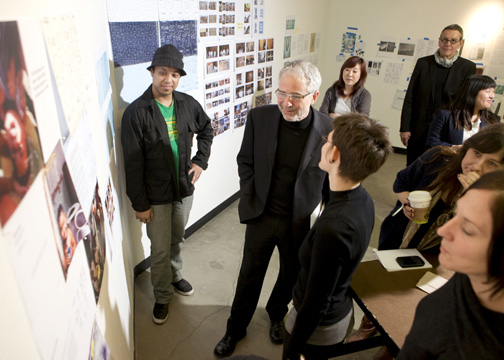
Buchman attends the "Safe Agua Peru" final, a course offered this year by the College's ground-breaking Designmatters program, which celebrates 10 years of social impact next year.
Dotted Line: You mentioned the strategic plan, which was initiated at the beginning of the year. Has it come to life as you imagined?
Buchman: Many of the initiatives I just enumerated point to the success of the strategic plan. The plan’s greatest strength rests with the fact that it is a community-created document. There is much to do and to build at Art Center, and the plan has helped us articulate our priorities and has served as a platform to organize our thoughts. However, as we implement the plan and see our ideas taking shape, we learn a great deal and our thinking becomes more precise. Good plans evolve and change in time. I’m in the midst of putting a call out to our various constituencies—people involved in the original planning process as well as new voices—to propose revisions to the plan, and I look forward to those revisions being adopted by the Board in April of next year.
Dotted Line: Speaking of the Board, with five new members, it has seen some significant growth this year. What is your hope for the Board going forward?
Buchman: We have some wonderful new trustees, and I couldn’t be more pleased with the Board’s growth. And we are talking to some great prospects as well. For all the ambitions evident in the strategic plan, we must continue to build on the strength of the Board, diversify its membership, and develop the capacity to make it all happen. We have made significant strides. Let me also say that Bob Davidson’s leadership as Chairman has been sensational. I love working with him. He is absolutely first-rate.
Dotted Line: Diversity gets a lot of attention in the strategic plan. What does diversity mean to Art Center?
Buchman: Shortly after launching the strategic plan, I appointed a new Council on Diversity and Inclusion, comprised of students, faculty, staff and alumni to help us define and realize our goals. The strategic plan does a good job of articulating the many ways in which diversity needs to be woven into the fabric of our culture as a whole, but the issues are complex and multifaceted. The Council, as part of our shared governance initiatives, will help guide our process. We need to move beyond an understanding of diversity as simply about representation of minorities, as important as that is. The values of diversity articulated in our plan speak to the core of who we are as an institution and the kind of education we need to offer students in the 21st century. They speak to how we approach the various disciplines we teach, the content of our courses and the kinds of questions we ask in the projects we assign. And they speak to how our faculty and our leadership think about art and design and how our work and the work of our students carries meaning, investigates identity and shapes culture. It’s about public outreach to communities in the greater L.A. area and well beyond. And it’s about funding and how we support a diverse community, all in the name of great and relevant art and design education.
Dotted Line: Art Center recently announced the creation of three new degree programs—Interaction Design, Graduate Environmental Design and Graduate Transportation Design. We already have a number of significant programs. Why add more?
Buchman: At the heart of the strategic plan is the need to be pertinent and to offer our students an education that is resonant with today’s world. Art Center needs to remain at the forefront of art and design education. Things change and these new programs, and the new Graduate Media Design Matters track, build on the College’s core competencies to ensure our students are prepared for the world they’re about to enter.
Dotted Line: Where do Art Center’s Public Programs fit in?
Buchman: Public Programs are a vitally important part of this institution and play an integral role in its future. Throughout the strategic plan we address topics such as access, affordability, partnerships and opportunity. Public Programs are the support system we’ll need to realize many of our goals. For instance, we’re outlining a plan to partner with high schools in underserved communities. Our idea is to prepare these high school students with the skill sets they will need for a college education in art or design. If we connect with these students as early as ninth grade, perhaps we can motivate them to achieve certain milestones in their high school career and even help prepare them for the possibility of an Art Center education. Our Public Programs are essential to making this happen. But beyond their service as “gateway” programs, Art Center for Kids, Saturday High and Art Center at Night are simply great community resources for those that want to broaden their knowledge and expand their horizons. And as South Campus becomes the center of greater activity, I see more mutually nourishing relationships between our public and degree programs.
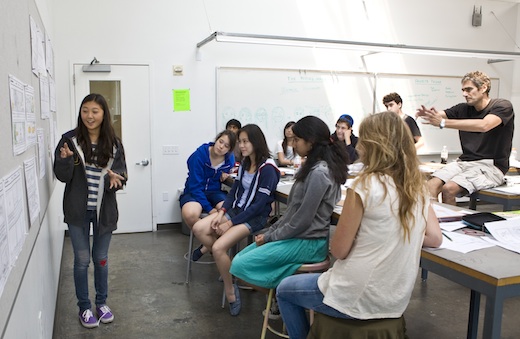
In Saturday High, students in grades 9-12 explore creative opportunities. Art Center's Public Programs also include Art Center at Night, Art Center for Kids and Summer Institute for Teachers. Photo: Vahe D'Ala.
Dotted Line: Which brings us to those “new spaces for learning.”
Buchman: Yes, there’s been a lot of progress regarding our two campuses, in large part due to active alumni support. I am thrilled to say that we’ve raised almost 85% of the money needed to acquire the post office property, all through alumni giving. Acquiring the post office property enhances not just South Campus, but will help decompress our crowded Hillside Campus as well. We’ll embark on a process in the new year with students, faculty and staff to ensure the best deployment of our programs across both campuses, guided by the core values of our mission.
Dotted Line: That kind of support from alumni must be gratifying. Why do you think they’ve responded so well to the strategic plan and the acquisition of the post office?
Buchman: The alumni believe in what we’re doing in the strategic plan and where we’re headed as an institution. The many letters I have received attest to enormous enthusiasm from our alumni, and they are coming forward with financial support to back up that excitement. They have responded so well because even as the plan represents the future of art and design education, it never strays from the fundamental DNA of this great institution. For the alumni, there’s also profound identification with our students and a shared sense of how tough it is to earn a degree from Art Center. Ultimately, I think that’s what alumni are responding to—a desire to support young artists and designers like themselves who want to obtain an Art Center education.
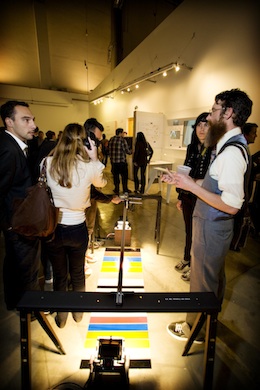
Held every Spring, 4 Hours Solid at South Campus highlights innovative work created by Art Center's graduate students. Photo: Four Eyes.
Dotted Line: With the expansion of South Campus there’s a lot of talk about “One College. Two Centers.” How do we bridge the gap, so to speak?
Buchman: First of all, it’s important to revise the “one college, two centers” notion because we’re working hard to develop online capacity to realize a third “virtual” campus as well. To be honest, it’ll take a few years to do it right, but we are making good progress. As for our brick-and-mortar campuses, we’ll create a shuttle system connecting them. In addition to serving as a vital link, the shuttle will reduce the number of trips students, faculty and staff are making up and down the hill; and that supports our sustainability initiatives as well.
Dotted Line: What is the importance of sustainability to Art Center?
Buchman: You can’t teach art and design responsibly in the 21st Century without sustainability being a core value. It has to penetrate all aspects not only of what we teach but how we model those values as an institution. I recently met with EcoCouncil and we discussed sustainability assessment tools being used by other schools in the Association of Independent Colleges of Art and Design. As a result, we’ll be forming a working group, akin to the Council on Diversity and Inclusion, to review sustainability issues across the College—operations, curriculum, programs—and the group will join EcoCouncil in making recommendations on how to meet sustainability challenges, especially in the development of our two-campus environment.
Dotted Line: What else can we look forward to in the coming year?
Buchman: There’s so much happening at Art Center in 2012. Our faculty will be hosting a symposium on teaching, our students are spearheading a special TEDx event, and Designmatters will celebrate its tenth anniversary in the Fall of next year. We’ll draw up an academic master plan for the remodel of the Ellwood building, imagine the totality of South Campus by building out the current facility together with the post office property, and make significant progress toward the important goal of building student housing. Finally, I am confident we will see even more progress in our fundraising initiatives as we develop a campaign to support scholarships, endowment and facilities.
Dotted Line: The launch of the strategic plan, announcement of new programs, the post office acquisition—it’s been a busy year for you and for Art Center. How are you going to spend the holidays?
Buchman: I’m looking forward to introducing myself to my kids and family. Hopefully, we will enjoy some quiet moments over break as we anticipate an exciting and rewarding 2012.

